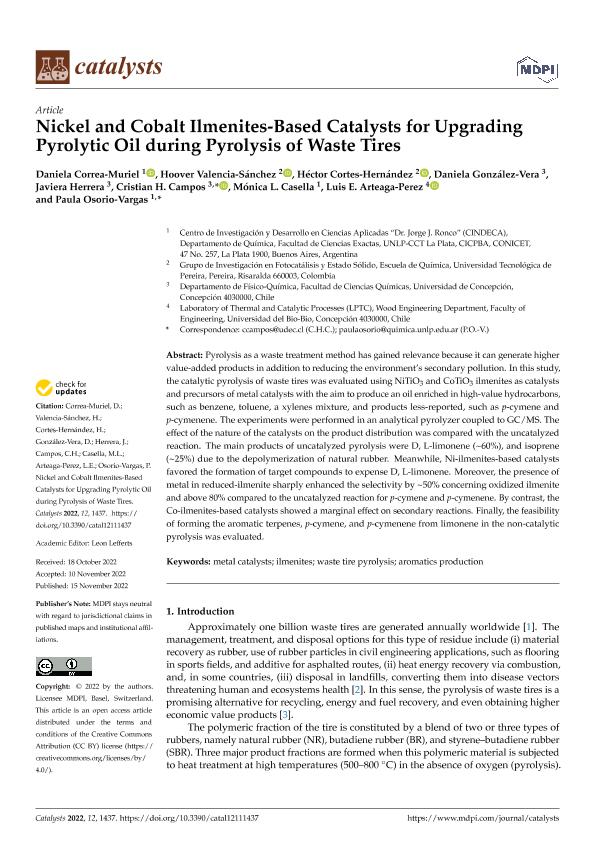Artículo
Nickel and Cobalt Ilmenites-Based Catalysts for Upgrading Pyrolytic Oil during Pyrolysis of Waste Tires
Correa Muriel, Daniela ; Valencia Sánchez, Hoover Albeiro; Cortes Hernández, Héctor; González Vera, Daniela; Herrera, Javiera; Campos, Cristian H.; Casella, Mónica Laura
; Valencia Sánchez, Hoover Albeiro; Cortes Hernández, Héctor; González Vera, Daniela; Herrera, Javiera; Campos, Cristian H.; Casella, Mónica Laura ; Arteaga Perez, Luis Ernesto; Osorio Vargas, Paula Alejandra
; Arteaga Perez, Luis Ernesto; Osorio Vargas, Paula Alejandra
 ; Valencia Sánchez, Hoover Albeiro; Cortes Hernández, Héctor; González Vera, Daniela; Herrera, Javiera; Campos, Cristian H.; Casella, Mónica Laura
; Valencia Sánchez, Hoover Albeiro; Cortes Hernández, Héctor; González Vera, Daniela; Herrera, Javiera; Campos, Cristian H.; Casella, Mónica Laura ; Arteaga Perez, Luis Ernesto; Osorio Vargas, Paula Alejandra
; Arteaga Perez, Luis Ernesto; Osorio Vargas, Paula Alejandra
Fecha de publicación:
11/2022
Editorial:
MDPI
Revista:
Catalysts
ISSN:
2073-4344
Idioma:
Inglés
Tipo de recurso:
Artículo publicado
Clasificación temática:
Resumen
Pyrolysis as a waste treatment method has gained relevance because it can generate higher value-added products in addition to reducing the environment’s secondary pollution. In this study, the catalytic pyrolysis of waste tires was evaluated using NiTiO3 and CoTiO3 ilmenites as catalysts and precursors of metal catalysts with the aim to produce an oil enriched in high-value hydrocarbons, such as benzene, toluene, a xylenes mixture, and products less-reported, such as p-cymene and p-cymenene. The experiments were performed in an analytical pyrolyzer coupled to GC/MS. The effect of the nature of the catalysts on the product distribution was compared with the uncatalyzed reaction. The main products of uncatalyzed pyrolysis were D, L-limonene (~60%), and isoprene (~25%) due to the depolymerization of natural rubber. Meanwhile, Ni-ilmenites-based catalysts favored the formation of target compounds to expense D, L-limonene. Moreover, the presence of metal in reduced-ilmenite sharply enhanced the selectivity by ~50% concerning oxidized ilmenite and above 80% compared to the uncatalyzed reaction for p-cymene and p-cymenene. By contrast, the Co-ilmenites-based catalysts showed a marginal effect on secondary reactions. Finally, the feasibility of forming the aromatic terpenes, p-cymene, and p-cymenene from limonene in the non-catalytic pyrolysis was evaluated.
Palabras clave:
AROMATICS PRODUCTION
,
ILMENITES
,
METAL CATALYSTS
,
WASTE TIRE PYROLYSIS
Archivos asociados
Licencia
Identificadores
Colecciones
Articulos(CINDECA)
Articulos de CENTRO DE INV EN CS.APLICADAS "DR.JORGE J.RONCO"
Articulos de CENTRO DE INV EN CS.APLICADAS "DR.JORGE J.RONCO"
Citación
Correa Muriel, Daniela; Valencia Sánchez, Hoover Albeiro; Cortes Hernández, Héctor; González Vera, Daniela; Herrera, Javiera; et al.; Nickel and Cobalt Ilmenites-Based Catalysts for Upgrading Pyrolytic Oil during Pyrolysis of Waste Tires; MDPI; Catalysts; 12; 11; 11-2022; 1-17
Compartir
Altmétricas



